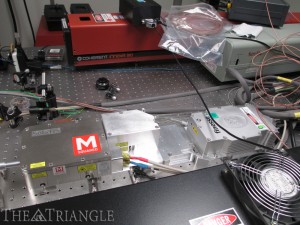Guannan Chen, a graduate student in Drexel’s materials science and engineering department, is part of a team of engineers led by Jonathan Spanier, a professor in Drexel’s College of Engineering, that is using laser spectroscopy to measure electron behavior in nanotechnology designs. His work, titled “Nano Letters,” was published Aug. 12 in the American Chemical Society publications.
The laser is used to measure electron behavior in nanoscale devices between two semiconductor pieces of material. The height of the energy step that an electron has to surpass is known as the band offset. This measurement is essential for creation of more efficient nanoscale components for small devices, such as smartphones.
“The nanostructure offers the opportunity for new device functions or even traditional functions whose performance is better. There is also bottleneck for current electronic devices, and they hope to use nanostructure again to revolutionize the field,” Chen said.
Existing methods are only applicable to planer devices, not nanoscale devices or nanowires.
“Many devices are designed based off the interface between two materials, but how to measure these properties, especially electronic behaviors, across this interface is rather difficult and it’s also ambiguous,” Chen said.
The team started with a laser-induced current in a nanowire device that depended on the wavelength of the laser and ended up with a new method to determine the band offset. By continuously changing the wavelength of the laser, they are able to measure the photocurrent responses and define the band offset from the data.
“If we want to more freely design devices, we need to get a better understanding of this offset. So that’s the motivation of this study, and luckily we found this approach to [measure the offset],” Chen said.
“The nanostructure can always give you something new that you can’t find in planer devices. … For this case we can make a new way to tune AC signal phase information,” Chen said.
Chen has been working on nanowires since he first came to Drexel four years ago.
He said he has maintained a positive outlook the entire time, even when receiving negative results.
“People become frustrated when they see negative results, but when I see negative results I didn’t expect, I spend time to see why that happened,” Chen said.
The next step is to get a better model of the device to conduct simulations. One thing Chen wants to do is bring the prototype to a higher speed so that there are no limitations.
This study is one component to a bigger project.
A 2011 study resulted in the discovery of the ability to study how electrons move from one material to the other, generating a hot electron transfer. At that time, the offset height could not be directly measured.
Drexel engineers are credited with designing the experiments, creating the nanowire device and conducting spectroscopic experiments. The study was funded by the National Science Foundation and included researchers from Lehigh University, the National Research Council’s Institute for Microelectronics and Microsystems, the University of Salento in Italy, the Weizmann Institute of Science, Negev Nuclear Research Center in Israel, and the University of Alabama.
Guan Sun and Yujie Ding from Lehigh University conducted complementary optical experiments. Paola Prete from the IMM-CNR and Ilio Miccoli and Nico Lovergine from the University of Salento teamed up with Hadas Shtrikman from the Weizmann Institute of Science to create the high-quality nanowire used for testing. Patrick Kung from the University of Alabama analyzed the atomic level of the composition of the nanowire, and Tsachi Livneh from the Negev Nuclear Research Center aided in analyzing the results.
Chen said he is very lucky to work with such great collaborators from around the world and to be able to share information among the group.


